无源光网络简介
- 格式:pptx
- 大小:1.55 MB
- 文档页数:53
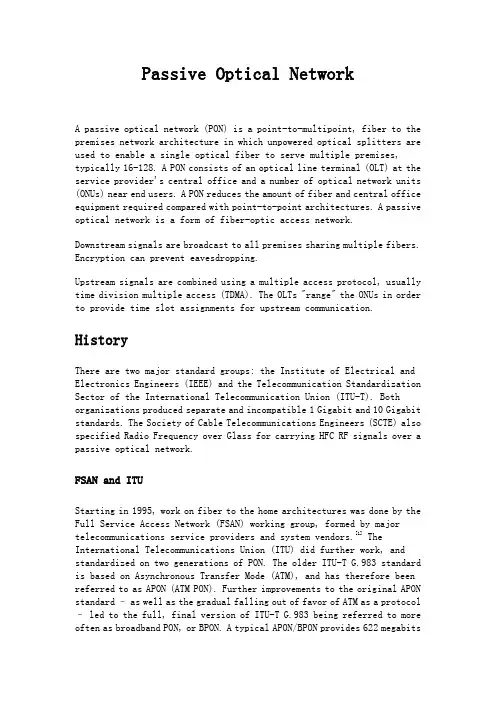
Passive Optical NetworkA passive optical network (PON) is a point-to-multipoint, fiber to the premises network architecture in which unpowered optical splitters are used to enable a single optical fiber to serve multiple premises, typically 16-128. A PON consists of an optical line terminal (OLT) at the service provider's central office and a number of optical network units (ONUs) near end users. A PON reduces the amount of fiber and central office equipment required compared with point-to-point architectures. A passive optical network is a form of fiber-optic access network.Downstream signals are broadcast to all premises sharing multiple fibers. Encryption can prevent eavesdropping.Upstream signals are combined using a multiple access protocol, usually time division multiple access (TDMA). The OLTs "range" the ONUs in order to provide time slot assignments for upstream communication.HistoryThere are two major standard groups: the Institute of Electrical and Electronics Engineers (IEEE) and the Telecommunication Standardization Sector of the International Telecommunication Union (ITU-T). Both organizations produced separate and incompatible 1 Gigabit and 10 Gigabit standards. The Society of Cable Telecommunications Engineers (SCTE) also specified Radio Frequency over Glass for carrying HFC RF signals over a passive optical network.FSAN and ITUStarting in 1995, work on fiber to the home architectures was done by the Full Service Access Network (FSAN) working group, formed by major telecommunications service providers and system vendors.[1] The International Telecommunications Union (ITU) did further work, and standardized on two generations of PON. The older ITU-T G.983 standard is based on Asynchronous Transfer Mode (ATM), and has therefore been referred to as APON (ATM PON). Further improvements to the original APON standard –as well as the gradual falling out of favor of ATM as a protocol – led to the full, final version of ITU-T G.983 being referred to more often as broadband PON, or BPON. A typical APON/BPON provides 622 megabitsper second (Mbit/s) (OC-12) of downstream bandwidth and 155 Mbit/s (OC-3) of upstream traffic, although the standard accommodates higher rates.The ITU-T G.984 Gigabit-capable Passive Optical Networks (GPON) standard represents a boost, compared to BPON, in both the total bandwidth and bandwidth efficiency through the use of larger, variable-length packets. Again, the standards permit several choices of bit rate, but the industry has converged on 2.488 gigabits per second (Gbit/s) of downstream bandwidth, and 1.244 Gbit/s of upstream bandwidth. GPON Encapsulation Method (GEM) allows very efficient packaging of user traffic with frame segmentation.By mid-2008, Verizon had installed over 800,000 lines. British Telecom, Mobily, Etisalat, and AT&T are in advanced trials in Britain, Saudi Arabia, the UAE, and the USA, respectively. GPON networks have now been deployed in numerous networks across the globe, and the trends indicate higher growth in GPON than other PON technologies.G.987 defined 10G-PON with 10 Gbit/s downstream and 2.5 Gbit/s upstream – framing is "G-PON like" and designed to coexist with GPON devices on the same network.[2]IEEEIn 2004, the Ethernet PON (EPON or GEPON) standard 802.3ah-2004 was ratified as part of the Ethernet in the first mile project of the IEEE 802.3. EPON uses standard 802.3 Ethernet frames with symmetric 1 Gigabit per second upstream and downstream rates. EPON is applicable fordata-centric networks, as well as full-service voice, data and video networks. 10Gbit/s EPON or 10G-EPON was ratified as an amendment IEEE 802.3av to IEEE 802.3. 10G-EPON supports 10/1 Gbit/s. The downstream wavelength plan support simultaneous operation of 10 Gbit/s on one wavelength and 1 Gbit/s on a separate wavelength for operation of IEEE 802.3av and IEEE 802.3ah on the same PON concurrently. The upstream channel can support simultaneous operation of IEEE 802.3av and 1 Gbit/s 802.3ah simultaneously on a single shared (1,310 nm) channel.There are currently over 40 million installed EPON ports making it the most widely deployed PON technology globally. EPON is also the foundation for cable operators’ business services as part of the DOCSIS Provisioning of EPON (DPoE) specifications.Network elementsA PON takes advantage of wavelength division multiplexing (WDM), using one wavelength for downstream traffic and another for upstream traffic on a single non-zero dispersion-shifted fiber (ITU-T G.652). BPON, EPON, GEPON, and GPON have the same basic wavelength plan and use the 1,490 nanometer (nm) wavelength for downstream traffic and 1,310 nm wavelength for upstream traffic. 1,550 nm is reserved for optional overlay services, typically RF (analog) video.As with bit rate, the standards describe several optical budgets, most common is 28 dB of loss budget for both BPON and GPON, but products have been announced using less expensive optics as well. 28 dB corresponds to about 20 km with a 32-way split. Forward error correction (FEC) may provide another 2–3 dB of loss budget on GPON systems. As optics improve, the 28 dB budget will likely increase. Although both the GPON and EPON protocols permit large split ratios (up to 128 subscribers for GPON, up to 32,768 for EPON), in practice most PONs are deployed with a split ratio of 1x32 or smaller.A PON consists of a central office node, called an optical line terminal (OLT), one or more user nodes, called optical network units (ONUs) or optical network terminals (ONTs), and the fibers and splitters between them, called the optical distribution network(ODN). “ONT” is an ITU-T term to describe a single-tenant ONU. In multiple-tenant units, the ONU may be bridged to a customer premises device within the individual dwelling unit using technologies such as Ethernet over twisted pair, G.hn (a high-speed ITU-T standard that can operate over any existing home wiring - power lines, phone lines and coaxial cables) or DSL. An ONU is a device that terminates the PON and presents customer service interfaces to the user. Some ONUs implement a separate subscriber unit to provide services such as telephony, Ethernet data, or video.An OLT provides the interface betw een a PON and a service provider′s core network. These typically include:∙IP traffic over Fast Ethernet, Gigabit Ethernet, or 10 Gigabit Ethernet;∙Standard TDM interfaces such as SDH/SONET;∙ATM UNI at 155–622 Mbit/s.The ONT or ONU terminates the PON and presents the native service interfaces to the user. These services can include voice (plain old telephone service (POTS) or voice over IP (VoIP)), data (typically Ethernet or V.35), video, and/or telemetry (TTL, ECL, RS530, etc.) Often the ONU functions are separated into two parts:∙The ONU, which terminates the PON and presents a converged interface—such as DSL, coaxial cable, or multiserviceEthernet—toward the user;∙Network termination equipment (NTE), which inputs the converged interface and outputs native service interfaces to the user, such as Ethernet and POTS.A PON is a shared network, in that the OLT sends a single stream of downstream traffic that is seen by all ONUs. Each ONU only reads the content of those packets that are addressed to it. Encryption is used to prevent eavesdropping on downstream traffic.Upstream bandwidth allocationThe OLT is responsible for allocating upstream bandwidth to the ONUs. Because the optical distribution network (ODN) is shared, ONU upstream transmissions could collide if they were transmitted at random times. ONUs can lie at varying distances from the OLT, meaning that the transmission delay from each ONU is unique. The OLT measures delay and sets a register in each ONU via PLOAM (physical layer operations and maintenance) messages to equalize its delay with respect to all of the other ONUs on the PON.Once the delay of all ONUs has been set, the OLT transmits so-called grants to the individual ONUs. A grant is permission to use a defined interval of time for upstream transmission. The grant map is dynamicallyre-calculated every few milliseconds. The map allocates bandwidth to all ONUs, such that each ONU receives timely bandwidth for its service needs.Some services – POTS, for example – require essentially constant upstream bandwidth, and the OLT may provide a fixed bandwidth allocation to each such service that has been provisioned. DS1 and some classes of data service may also require constant upstream bit rate. But much data traffic, such as browsing web sites, is bursty and highly variable. Through dynamic bandwidth allocation (DBA), a PON can be oversubscribed for upstream traffic, according to the traffic engineering concepts of statistical multiplexing. (Downstream traffic can also be oversubscribed, in the same way that any LAN can be oversubscribed. The only special feature in the PON architecture for downstream oversubscription is the fact that the ONU must be able to accept completely arbitrary downstream time slots, both in time and in size.)In GPON there are two forms of DBA, status-reporting (SR) and non-status reporting (NSR).In NSR DBA, the OLT continuously allocates a small amount of extra bandwidth to each ONU. If the ONU has no traffic to send, it transmits idle frames during its excess allocation. If the OLT observes that a given ONU is not sending idle frames, it increases the bandwidth allocation to that ONU. Once the ONU's burst has been transferred, the OLT observes a large number of idle frames from the given ONU, and reduces its allocation accordingly. NSR DBA has the advantage that it imposes no requirements on the ONU, and the disadvantage that there is no way for the OLT to know how best to assign bandwidth across several ONUs that need more.In SR DBA, the OLT polls ONUs for their backlogs. A given ONU may have several so-called transmission containers (T-CONTs), each with its own priority or traffic class. The ONU reports each T-CONT separately to the OLT. The report message contains a logarithmic measure of the backlog in the T-CONT queue. By knowledge of the service level agreement for each T-CONT across the entire PON, as well as the size of each T-CONT's backlog, the OLT can optimize allocation of the spare bandwidth on the PON.EPON systems use a DBA mechanism equivalent to GPON's SR DBA solution. The OLT polls ONUs for their queue status and grants bandwidth using the MPCP GATE message, while ONUs report their status using the MPCP REPORT message.VariantsTDM-PONBoth APON/BPON and EPON/GEPON were deployed widely, but most networks designed in 2008 use GPON or GEPON. GPON has fewer than 2 million installed ports. GEPON has approximately 30 million deployed ports. For TDM-PON, a passive power splitter is used as the remote terminal. Each ONUs (Optical network units) signals are multiplexed in the time domain. ONUs see their own data through the address labels embedded in the signal.DOCSIS Provisioning of EPON or DPoEData Over Cable Service Interface Specification (DOCSIS) Provisioning of Ethernet Passive Optical Network, or DPoE, is a set of Cable Television Laboratory specifications that implement the DOCSIS service layer interface on existing Ethernet PON (EPON, GEPON or 10G-EPON) Media Access Control (MAC) and Physical layer (PHY) standards. In short it implements the DOCSIS Operations Administration Maintenance and Provisioning (OAMP)functionality on existing EPON equipment. It makes the EPON OLT look and act like a DOCSIS Cable Modem Termination Systems (CMTS) platform (which is called a DPoE System in DPoE terminology). In addition to offering the same IP service capabilities as a CMTS, DPoE supports Metro Ethernet Forum (MEF) 9 and 14 services for the delivery of Ethernet services for business customers.RFoG[edit]Radio Frequency over Glass (RFoG) is a type of passive optical networking, that transports RF signals that are now transported over copper (principally over a hybrid fibre-coaxial cable) over PON. In the forward direction RFoG is either a stand alone P2MP system or an optical overlay for existing PON such as GEPON/EPON. The overlay for RFoG is based on Wave Division Multiplexing (WDM) -- the passive combination of wavelengths on a single strand of glass. Reverse RF support is provided by transporting the upstream or return RF into on a separate lambda from the PON return wavelength. The Society of Cable and Telecommunications Engineers (SCTE) Interface Practices Subcomittee (IPS) Work Group 5, is currently working on IPS 910 RF over Glass. RFoG offers backwards compatibility with existing RF modulation technology, but offers no additional bandwidth for RF based services. Although not yet completed, the RFoG standard is actually a collection of standardized options which are not compatible with each other (they cannot be mixed on the same PON). Some of the standards may interoperate with other PONs, others may not. It offers a means to support RF technologies in locations where only fiber is available or where copper is not permitted or feasible. This technology is targeted towards Cable TV operators and their existing HFC networks.WDM-PONWavelength Division Multiplexing PON, or WDM-PON, is a non-standard type of passive optical networking, being developed by some companies.The multiple wavelengths of a WDM-PON can be used to separate Optical Network Units (ONUs) into several virtual PONs co-existing on the same physical infrastructure. Alternatively the wavelengths can be used collectively through statistical multiplexing to provide efficient wavelength utilization and lower delays experienced by the ONUs.There is no common standard for WDM-PON nor any unanimously agreed upon definition of the term. By some definitions WDM-PON is a dedicated wavelength for each ONU. Other more liberal definitions suggest the useof more than one wavelength in any one direction on a PON is WDM-PON. It is difficult to point to an un-biased list of WDM-PON vendors when there is no such unanimous definition. PONs provide higher bandwidth than traditional copper based access networks. WDM-PON has better privacy and better scalability because of each ONU only receives its own wavelength.Advantages: The MAC layer is simplified because the P2P connections between OLT and ONUs are realized in wavelength domain, so no P2MP media access control is needed. In WDM-PON each wavelength can run at a different speed and protocol so there is an easy pay-as-you-grow upgrade.Challenges: High cost of initial set-up, the cost of the WDM components. Temperature control is another challenge because of how wavelengths tend to drift with environmental temperatures.Long-Reach Optical Access NetworksThe concept of the Long-Reach Optical Access Network (LROAN) is to replace the optical/electrical/optical conversion that takes place at the local exchange with a continuous optical path that extends from the customer to the core of the network. Work by Davey and Payne at BT showed that significant cost savings could be made by reducing the electronic equipment and real-estate required at the local exchange or wire center.[3] A proof of concept demonstrator showed that it was possible to serve 1024 users at 10GBit/s with 100 km reach.[4]This technology has sometimes been termed Long-Reach PON, however, many argue that the term PON is no longer applicable as, in most instances, only the distribution remains passive.Enabling technologiesDue to the topology of PON, the transmission modes for downstream (that is, from OLT to ONU) and upstream (that is, from ONU to OLT) are different. For the downstream transmission, the OLT broadcasts optical signal to all the ONUs in continuous mode (CM), that is, the downstream channel always has optical data signal. However, in the upstream channel, ONUs can not transmit optical data signal in CM. Use of CM would result in all of the signals transmitted from the ONUs converging (with attenuation) into one fiber by the power splitter (serving as power coupler), and overlapping. To solve this problem, burst mode (BM) transmission is adopted for upstream channel. The given ONU only transmits optical packet when it is allocated a time slot and it needs to transmit, and all the ONUs sharethe upstream channel in the time division multiplexing (TDM) mode. The phases of the BM optical packets received by the OLT are different from packet to packet, since the ONUs are not synchronized to transmit optical packet in the same phase, and the distance between OLT and given ONU are random. Since the distance between the OLT and ONUs are not uniform, the optical packets received by the OLT may have different amplitudes. In order to compensate the phase variation and amplitude variation in a short time (for example within 40 ns for GPON[5]), burst mode clock and data recovery (BM-CDR) and burst mode amplifier (for example burst mode TIA) need to be employed, respectively. Furthermore, the BM transmission mode requires the transmitter to work in burst mode. Such a burst mode transmitter is able to turn on and off in short time. The above three kinds of circuitries in PON are quite different from their counterparts in the point-to-point continuous mode optical communication link.Fiber to the premisesMain article: Fiber to the xPassive optical networks do not use electrically powered components to split the signal. Instead, the signal is distributed using beam splitters. Each splitter typically splits the signal from a single fiber into 16, 32, or 64 fibers, depending on the manufacturer, and several splitters can be aggregated in a single cabinet. A beam splitter cannot provide any switching or buffering capabilities and doesn't use any power supply; the resulting connection is called a point-to-multipoint link. For such a connection, the optical network terminals on the customer's end must perform some special functions which would not otherwise be required. For example, due to the absence of switching, each signal leaving the central office must be broadcast to all users served by that splitter (including to those for whom the signal is not intended). It is therefore up to the optical network terminal to filter out any signals intended for other customers. In addition, since splitters have no buffering, each individual optical network terminal must be coordinated in a multiplexing scheme to prevent signals sent by customers from colliding with each other. Two types of multiplexing are possible for achieving this:wavelength-division multiplexing and time-division multiplexing. With wavelength-division multiplexing, each customer transmits their signal using a unique wavelength. With time-division multiplexing (TDM), the customers "take turns" transmitting information. TDM equipment has been on the market longest. Because there is no single definition of "WDM-PON" equipment, various vendors claim to have released the 'first' WDM-PON equipment, but there is no consensus on which product was the 'first' WDM-PON product to market.Passive optical networks have both advantages and disadvantages over active networks. They avoid the complexities involved in keeping electronic equipment operating outdoors. They also allow for analog broadcasts, which can simplify the delivery of analog television. However, because each signal must be pushed out to everyone served by the splitter (rather than to just a single switching device), the central office must be equipped with a particularly powerful piece of transmitting equipment called an optical line terminal (OLT). In addition, because each customer's optical network terminal must transmit all the way to the central office (rather than to just the nearest switching device), reach extenders would be needed to achieve the distance from central office that is possible with outside plant based active optical networks.Optical distribution networks can also be designed in a point-to-point "homerun" topology where splitters and/or active networking are all located at the central office, allowing users to be patched into whichever network is required from the optical distribution frame.Passive optical componentsThe drivers behind the modern passive optical network are high reliability, low cost, passive functionality.Single-mode, passive optical components include branching devices such as Wavelength-Division Multiplexer/Demultiplexers– (WDMs), isolators, circulators, and filters. These components are used in interoffice, loop feeder, Fiber In The Loop (FITL), Hybrid Fiber-Coaxial Cable (HFC), Synchronous Optical Network (SONET), and Synchronous Digital Hierarchy (SDH) systems; and other telecommunications networks employing optical communications systems that utilize Optical Fiber Amplifiers (OFAs) and Dense Wavelength Division Multiplexer (DWDM) systems. Industry proposed requirements for these components are detailed in GR-1209, Generic Requirements for Passive Optical Components.The broad variety of passive optical components applications include multichannel transmission, distribution, optical taps for monitoring, pump combiners for fiber amplifiers, bit-rate limiters, optical connects, route diversity, polarization diversity, interferometers, and conherent communication.WDMs are optical components in which power is split or combined based on the wavelength composition of the optical signal. Dense Wavelength Division Multiplexers (DWDMs) are optical components that split power over at least four wavelengths. Wavelength insensitive couplers arepassive optical components in which power is split or combined independently of the wavelength composition of the optical signal. A given component may combine and divide optical signals simultaneously, as in bidirectional (duplex) transmission over a single fiber. Passive optical components are data format transparent, combining and dividing optical power in some predetermined ratio (coupling ratio) regardless of the information content of the signals. WDMs can be thought of as wavelength splitters and combiners. Wavelength insensitive couplers can be thought of as power splitters and combiners.An optical isolator is a two-port passive component that allows light (in a given wavelength range) to pass through with low attenuation in one direction, while isolating (providing a high attenuation for) light propagating in the reverse direction. Isolators are used as both integral and in-line components in laser diode modules and optical amplifiers, and to reduce noise caused by multi-path reflection in highbit-rate and analog transmission systems.An optical circulator operates in a similar way to an optical isolator, except that the reverse propagating lightwave is directed to a third port for output, instead of being lost. An optical circulator can be used for bidirectional transmission, as a type of branching component that distributes (and isolates) optical power among fibers, based on the direction of the lightwave propagation.A fiber optic filter is a component with two or more ports that provides wavelength sensitive loss, isolation and/or return loss. Fiber optic filters are in-line, wavelength selective, components that allow a specific range of wavelengths to pass through (or reflect) with low attenuation for classification of filter types).。

PON网络知识介绍PON网络(Passive Optical Network)又称为无源光纤网络,是一种基于光纤传输技术的宽带接入网络。
与传统的以电信号为传输媒介的网络相比,PON网络具有更高的带宽、更远的传输距离和更低的成本。
PON网络的原理是在光纤传输链路中使用无源光纤设备,将光纤传输链路划分为不同的分支,每个分支连接到终端用户。
光信号从中心节点传输到终端用户的过程中,不需要额外的光源和光放大器进行增强,而是通过分光器进行分配和光栅进行反射,实现信号的传输。
这种设计使得光信号可以同时传输给多个用户,提高了网络的利用率。
光线路终端(OLT)是PON网络的中心节点,负责管理和控制整个网络。
OLT与电信运营商的核心网相连,并通过光纤链路将信号传输给ONU。
同时,OLT也负责对网络中的光信号进行调度和控制,以满足不同用户的需求。
光网络单元(ONU)是连接到终端用户的设备,通过PON网络接收和发送光信号。
每个终端用户都会有一个独立的ONU。
ONU可以是家庭用户的宽带接入设备,也可以是办公楼、学校等机构的网络终端设备。
ONU负责与OLT进行通信,将光信号转换成电信号,并将数据传输到用户终端设备。
光纤分配器(ODN)是将光信号从OLT分发到不同的用户分支的装置。
ODN将光信号分成不同的波长,然后通过分光器将其传输到不同的终端用户。
这种设计使得光信号可以在不同的用户之间共享,提高了网络的利用率。
PON网络具有许多优点。
首先,它提供了高带宽的网络接入,可以满足用户对高速互联网和大带宽应用的需求。
其次,PON网络的传输距离可以达到几十公里,远远超过了传统的电线传输距离。
此外,PON网络的构建成本较低,因为它使用了无源光纤设备,减少了能耗和维护成本。
然而,PON网络也存在一些挑战和限制。
首先,由于光纤传输链路的共享特性,网络的带宽会随着用户数量的增加而减少。
其次,由于是无源光纤网络,因此在信号传输过程中可能会存在一些损耗和衰减。
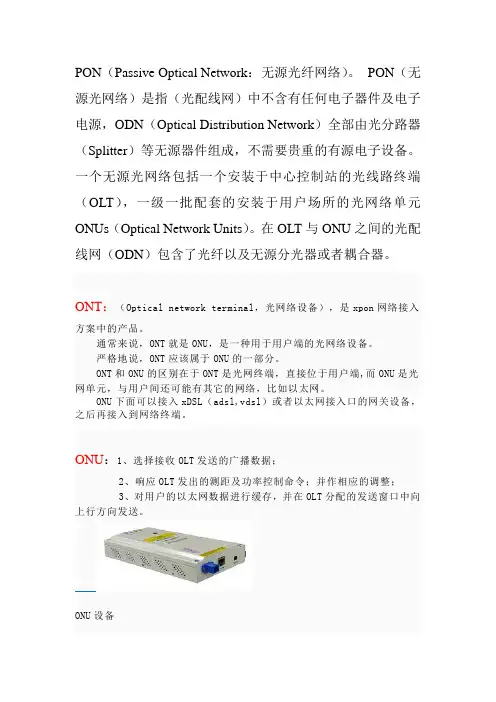
PON(Passive Optical Network:无源光纤网络)。
PON(无源光网络)是指(光配线网)中不含有任何电子器件及电子电源,ODN(Optical Distribution Network)全部由光分路器(Splitter)等无源器件组成,不需要贵重的有源电子设备。
一个无源光网络包括一个安装于中心控制站的光线路终端(OLT),一级一批配套的安装于用户场所的光网络单元ONUs(Optical Network Units)。
在OLT与ONU之间的光配线网(ODN)包含了光纤以及无源分光器或者耦合器。
ONT:(Optical network terminal,光网络设备),是xpon网络接入方案中的产品。
通常来说,ONT就是ONU,是一种用于用户端的光网络设备。
严格地说,ONT应该属于ONU的一部分。
ONT和ONU的区别在于ONT是光网终端,直接位于用户端,而ONU是光网单元,与用户间还可能有其它的网络,比如以太网。
ONU下面可以接入xDSL(adsl,vdsl)或者以太网接入口的网关设备,之后再接入到网络终端。
ONU:1、选择接收OLT发送的广播数据;2、响应OLT发出的测距及功率控制命令;并作相应的调整;3、对用户的以太网数据进行缓存,并在OLT分配的发送窗口中向上行方向发送。
ONU设备完全符合IEEE 802.3/802.3ah·接收灵敏度高达-25.5dBm·发送功率高达-1至+4dBm·PON使用单光纤连接到OLT,然后OLT连接到ONU。
ONU提供数据、IPTV(即交互式网络电视),语音(使用IAD,即Integrated Access Device 综合接入设备)等业务,真正实现“triple-play”应用。
OLT:1、向ONU(光网络分配单元)以广播方式发送以太网数据;2、发起并控制测距过程,并记录测距信息;3、为ONU分配带宽;即控制ONU发送数据的起始时间和发送窗口大小.EPON无源光网络系统中的局端设备(OLT),是一个多业务提供平台,同时支持IP业务和传统的TDM业务。
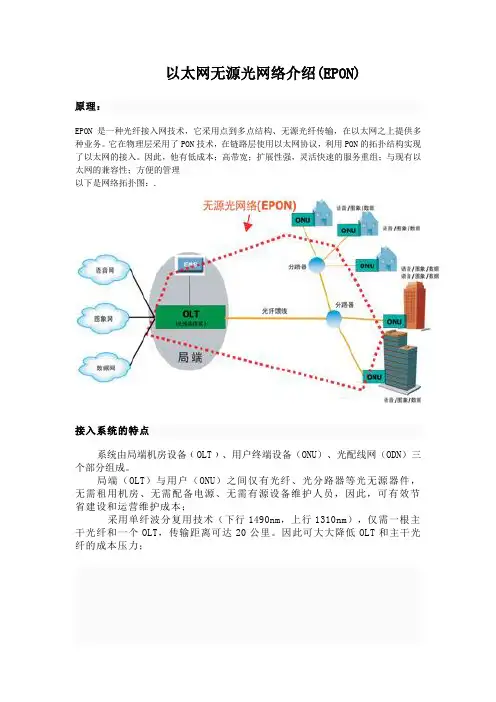
以太网无源光网络介绍(EPON)原理:EPON是一种光纤接入网技术,它采用点到多点结构、无源光纤传输,在以太网之上提供多种业务。
它在物理层采用了PON技术,在链路层使用以太网协议,利用PON的拓扑结构实现了以太网的接入。
因此,他有低成本;高带宽;扩展性强,灵活快速的服务重组;与现有以太网的兼容性;方便的管理以下是网络拓扑图:.接入系统的特点系统由局端机房设备﹙OLT﹚、用户终端设备(ONU)、光配线网(ODN)三个部分组成。
局端(OLT)与用户(ONU)之间仅有光纤、光分路器等光无源器件,无需租用机房、无需配备电源、无需有源设备维护人员,因此,可有效节省建设和运营维护成本;采用单纤波分复用技术(下行1490nm,上行1310nm),仅需一根主干光纤和一个OLT,传输距离可达20公里。
因此可大大降低OLT和主干光纤的成本压力;设备介绍华为 SmartAX MA5680T(OLT)华为 SmartAX MA5680T-EPON/GPON系统OLT光接入设备是华为EPON/GPON系统中OLT (Optical LineTerminal)设备,和终端ONU(Optical NetworkUnit)设备配合使用,可以提供EPON/GPON接入业务,满足FTTH(Fiber To The Home)光纤到户、FTTB(FiberTo The Building)光纤到楼、基站传输、IP专线互联、批发等组网需求。
MA5680T拥有海量的交换容量达到400G,每槽位带宽高达10G,并且支持20G的上行带宽。
MA5680T是目前业界第一款T比特(1000G)的宽带接入产品。
MA5680T支持目前所有的光接入方式,包括:EPON、GPON、千兆光以太网、百兆光以太网,只需插入不同的接口板就可以支持不同的光接入方式,各种光接口板可以随意的混插,为运营商提供了一个极其灵活的光接入平台:可以提供EPON和GPON的接入方式,实现FTTX,并且可以避免技术选择的风险;可以提供千兆光以太网接口,作为DSLAM或交换机的光汇聚设备;可以提供百兆光以太网接口,作为大客户的高速接入;MA5680T作为接入层光纤接入的汇聚平台,可以为运营商提供丰富的光纤接入手段,满足接入层多样化的接入需求和多元的光接入手段相配套的,是多样化的远端ONU,根据光纤延伸的位置不同,MA5680T可以提供不同类型的ONU,包括家庭型、楼道型、户外型等,为运营商提供完整的FTTX解决方案。

无源光网络无源光网络是一种新兴的通信技术,它采用光波传输信号,具有高速、大带宽、低延迟等优点。
本文将从无源光网络的基本原理、应用领域和未来发展等方面进行探讨。
无源光网络是一种基于光传输的通信网络,它主要通过利用光的特性传输信号。
光波在光纤中传输速度非常快,因此无源光网络具有极高的传输速率。
同时,光信号不受电磁干扰,在传输过程中很少有信号损耗,因此具有较低的传输延迟和可靠性。
无源光网络的基本原理是利用光纤传输信号,其中无源表示无需外界能量输入的光源。
在无源光网络中,光信号通过光纤进行传输,光信号的发射和接收通常由半导体器件完成。
发射端的激光器可以将电信号转化为光信号,而接收端的光电二极管则将光信号转化为电信号。
无源光网络可以应用于多个领域。
首先,它在电信领域具有广泛的应用。
由于无源光网络具有高速、大带宽的特点,可以满足高清视频传输、大容量数据传输等需求。
其次,无源光网络在计算机领域也有很大的用途。
现代计算机的数据处理速度越来越快,对通信速率有更高的要求,无源光网络可以满足这些需求。
此外,无源光网络还可以应用于军事通信、智能交通等领域。
未来,无源光网络有着广阔的发展前景。
随着网络技术的不断进步,无源光网络将得到进一步的优化和改进,可以适应更多的应用场景。
例如,随着5G技术的普及,对通信速率和延迟的要求将更高,无源光网络可以满足这些需求。
此外,随着物联网的快速发展,无源光网络也可以成为连接智能设备的主要手段。
值得注意的是,虽然无源光网络在传输速率和可靠性方面具有很大优势,但也存在一些挑战。
首先,无源光网络的建设和维护成本相对较高,需要大量的光纤和相关设备。
其次,无源光网络对环境要求较高,例如温度、湿度等因素对光信号的传输有一定影响。
此外,无源光网络在安全性方面也需要加强,以防止信息泄露和黑客攻击。
综上所述,无源光网络是一种基于光传输的新兴通信技术,具有高速、大带宽、低延迟等优点。
它可以应用于电信、计算机、军事通信等多个领域,并在未来有着广阔的发展前景。
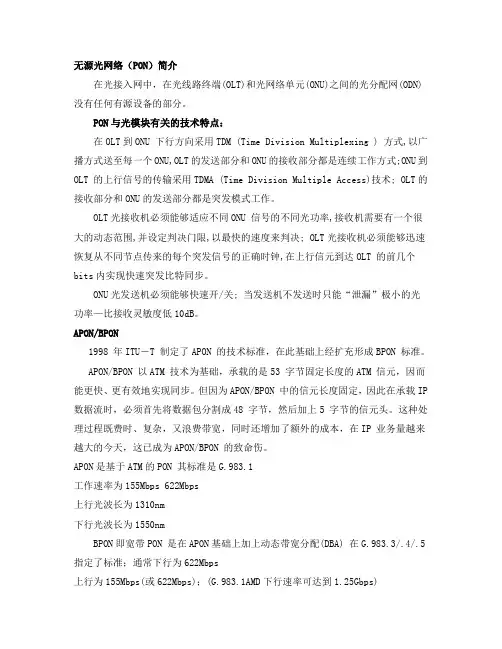
无源光网络(PON)简介在光接入网中,在光线路终端(OLT)和光网络单元(ONU)之间的光分配网(ODN)没有任何有源设备的部分。
PON与光模块有关的技术特点:在OLT到ONU 下行方向采用TDM (Time Division Multiplexing ) 方式,以广播方式送至每一个ONU,OLT的发送部分和ONU的接收部分都是连续工作方式;ONU到OLT 的上行信号的传输采用TDMA (Time Division Multiple Access)技术; OLT的接收部分和ONU的发送部分都是突发模式工作。
OLT光接收机必须能够适应不同ONU 信号的不同光功率,接收机需要有一个很大的动态范围,并设定判决门限,以最快的速度来判决; OLT光接收机必须能够迅速恢复从不同节点传来的每个突发信号的正确时钟,在上行信元到达OLT 的前几个bits内实现快速突发比特同步。
ONU光发送机必须能够快速开/关; 当发送机不发送时只能“泄漏”极小的光功率—比接收灵敏度低10dB。
APON/BPON1998 年ITU-T 制定了APON 的技术标准,在此基础上经扩充形成BPON 标准。
APON/BPON 以ATM 技术为基础,承载的是53 字节固定长度的ATM 信元,因而能更快、更有效地实现同步。
但因为APON/BPON 中的信元长度固定,因此在承载IP 数据流时,必须首先将数据包分割成48 字节,然后加上5 字节的信元头。
这种处理过程既费时、复杂,又浪费带宽,同时还增加了额外的成本,在IP 业务量越来越大的今天,这已成为APON/BPON 的致命伤。
APON是基于ATM的PON 其标准是G.983.1工作速率为155Mbps 622Mbps上行光波长为1310nm下行光波长为1550nmBPON即宽带PON 是在APON基础上加上动态带宽分配(DBA) 在G.983.3/.4/.5指定了标准;通常下行为622Mbps上行为155Mbps(或622Mbps);(G.983.1AMD下行速率可达到1.25Gbps)上行光波长为1310nm下行光波长为1490nmGPONGPON(Gigabit-capable passive optical networks)千兆无源光网络支持全方位服务-包括话音(TDM、PDH和SONET/SDH)、Ethernet(10/100 Base T)、ATM、专线等等.因此,运营商对GPON非常感兴趣。

什么是EPON/无源光网络(PON)EPON是什么意思无源光网络(PON)的概念由来已久,它具有节省光纤资源、对网络协议透明的的特点,在光接入网中扮演着越来越重要的角色。
同时,以太网(Ethernet)技术经过二十年的发展,以其简便实用,价格低廉的特性,几乎已经完全统治了局域网,并在事实上被证明是承载IP数据包的最佳载体。
随着IP业务在城域和干线传输中所占的比例不断攀升,以太网也在通过传输速率、可管理性等方面的改进,逐渐向接入、城域甚至骨干网上渗透。
而以太网与PON的结合,便产生了以太网无源光网络(EPON)。
它同时具备了以太网和PON的优点,正成为光接入网领域中的热门技术。
PON技术的发展:APON(ATM PON)1995年提出,1996年由13家大型网络运营商同它们的主要设备供应商组成了FSAN (Full Service Access Network)联盟,155Mb/s的PON系统技术规范,ATM传输协议,ITU-T G.983系列标准;BPON(Broadband PON)2001年,APON标准后来得到了加强,可支持622Mb/s的传输速率,同时加上了动态带宽分配、保护等功能,能提供以太网接入、视频发送、高速租用线路等业务,宽带的PON;GPON(Gigabit PON)FSAN联盟进行1Gb/s以上速率的PON标准研究,希望提出一种方案,除了能运行在更高的速率外,还要在多业务、OAM&P、可扩缩性等方面较之其它的PON效率更高。
这一研究使得Gigabit PON(GPON)出现。
2003年1月,ITU-T批准确立了GPON标准G.984.1、G.984.2和G.984.3;EPON(Ethernet PON)2000年11月,IEEE成立了802.3 EFM(Ethernet in the First Mile)研究组,业界有21个网络设备制造商发起成立了EFMA,实现Gb/s以太网点到多点的光传送方案,所以又称GEPON (GigabitEthernet PON)。

光电通信中的无源光网络技术随着信息技术的飞跃发展,光电通信已经成为现代通信领域的一项重要技术,其速度、带宽和稳定性等方面都远超传统通信方式。
而光网络技术则是光电通信的核心技术之一,光网络技术的形式多种多样,其中无源光网络技术已逐渐成为研究的热点。
什么是无源光网络技术?简单来说,无源光网络技术是一种基于纯光学方式来实现光信号传输、分配、管理和控制的技术手段。
该技术通过光时分复用技术(TDMA)和光波分复用技术(WDM)等来实现高效的光信号传输,从而可以实现局域网、城域网、广域网等多级光网络的构建。
并且这种技术采用全光无源网络结构,具有无递归连接、无电子路由和无光放大等特点,能够实现抗电磁干扰、保证传输质量、降低能耗等优势,更加符合大数据、云计算等高速数据存取场景的需求。
在现代社会中,网络信息安全问题日益凸显,光网络的安全性也是非常重要的一个问题。
而无源光网络技术不仅在传输速度、带宽、可靠性上具有巨大优势,同时在数据信息的安全性上也得到了很好的体现。
由于无源光网络结构中不存在关键分组的缓存、处理以及转发,因此在黑客攻击等安全攻击时,也很难收到影响,大大提升了数据的安全性。
除此之外,无源光网络技术的广泛应用也在逐渐加速。
例如在高速列车上,随着商务、旅游、文化交流等人们活动范围不断扩大,需要解决在高速列车上网络传输中的信息瓶颈和安全问题,这可以借助无源光网络技术来实现。
同时,无源光网络技术在石油、化工、航空等领域也得到了广泛应用。
综上,无源光网络技术具有高速、大流量、低时延、高安全性、能耗低等优点,已经成为现代通信领域必备技术之一。
在未来数字经济的发展中,无源光网络技术将会得到更加广泛的应用,也必将推动中华民族通信科技的进一步发展。
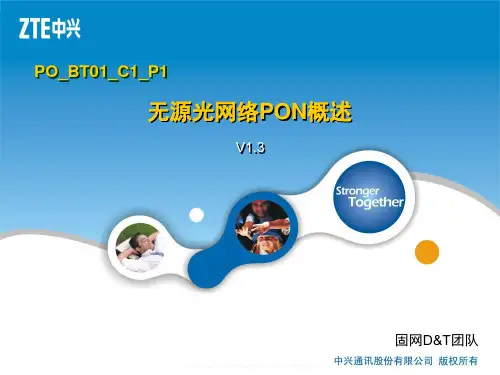

什么是无源光网络无源光网络(Passive Optical Network, PON)是一种纯介质网络,避免了外部设备的电磁干扰和雷电影响,减少线路和外部设备的故障率,提高了系统可靠性,同时节省了维护成本,是电信维护部门长期期待的技术。
一起来了解一下关于无源光网络的相关知识吧。
无源光网络是什么无源光网络(Passive Optical Network, PON)是一种纯介质网络,避免了外部设备的电磁干扰和雷电影响,减少线路和外部设备的故障率,提高了系统可靠性,同时节省了维护成本,是电信维护部门长期期待的技术。
无光源网络是一种点对多点的光纤传输和接入技术,下行采用广播方式、上行采用时分多址方式,可以灵活地组成树形、星型、总线型等拓扑结构,在光分支点只需要暗转一个简单的光分支器即可,因此具有节省光缆资源、带宽资源共享、节省机房投资、建网速度快、综合建网成本低等优点。
无源光网络包括ATM-PON和Ethernet-PON两种。
无源光网络的原理和构成PON包括ATM-PON(APON,即基于ATM的无源光网络)和Ethernet-PON(EPON,即基于以太网的无源光网络)两种。
如今的高校小区普遍采用的是EPON,作为当下网络工程重点考查和关注的知识点,有必要对PON技术做一个深入的学习!PON(无源光网络)技术是一种点对多点的光纤传输和接入技术,下行采用广播方式、上行采用时分多址方式,可以灵活地组成树型、星型、总线型等拓朴结构,在光分支点不需要节点设备,只需要安装一个简单的光分支器即可,因此具有节省光缆资源、带宽资源共享、节省机房投资、设备安全性高、建网速度快、综合建网成本低等优点。
无源光网络的现状与趋势接入网是用户进入城域网/骨干网的桥梁,是信息传送通道的“最后一公里”。
过去几年,网络的核心部分发生了翻天覆地的变化,无论是交换、还是传输都己更新换代,而接入网由于经济性问题如用户的业务需求、用户密度、用户的经济承受能力等多方面原因发展缓慢,成为制约网络向宽带化、全业务化发展的瓶颈。
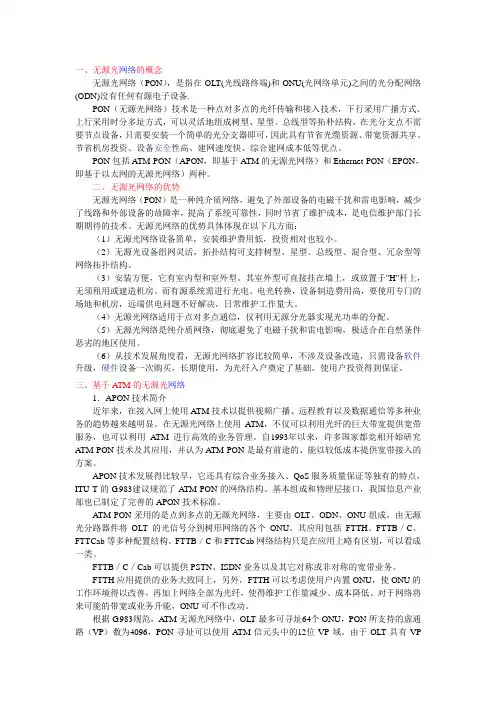
一、无源光网络的概念无源光网络(PON),是指在OLT(光线路终端)和ONU(光网络单元)之间的光分配网络(ODN)没有任何有源电子设备.PON(无源光网络)技术是一种点对多点的光纤传输和接入技术,下行采用广播方式、上行采用时分多址方式,可以灵活地组成树型、星型、总线型等拓朴结构,在光分支点不需要节点设备,只需要安装一个简单的光分支器即可,因此具有节省光缆资源、带宽资源共享、节省机房投资、设备安全性高、建网速度快、综合建网成本低等优点。
PON包括ATM-PON(APON,即基于ATM的无源光网络)和Ethernet-PON(EPON,即基于以太网的无源光网络)两种。
二、无源光网络的优势无源光网络(PON)是一种纯介质网络,避免了外部设备的电磁干扰和雷电影响,减少了线路和外部设备的故障率,提高了系统可靠性,同时节省了维护成本,是电信维护部门长期期待的技术。
无源光网络的优势具体体现在以下几方面:(1)无源光网络设备简单,安装维护费用低,投资相对也较小。
(2)无源光设备组网灵活,拓扑结构可支持树型、星型、总线型、混合型、冗余型等网络拓扑结构。
(3)安装方便,它有室内型和室外型。
其室外型可直接挂在墙上,或放置于"H"杆上,无须租用或建造机房。
而有源系统需进行光电、电光转换,设备制造费用高,要使用专门的场地和机房,远端供电问题不好解决,日常维护工作量大。
(4)无源光网络适用于点对多点通信,仅利用无源分光器实现光功率的分配。
(5)无源光网络是纯介质网络,彻底避免了电磁干扰和雷电影响,极适合在自然条件恶劣的地区使用。
(6)从技术发展角度看,无源光网络扩容比较简单,不涉及设备改造,只需设备软件升级,硬件设备一次购买,长期使用,为光纤入户奠定了基础,使用户投资得到保证。
三、基于ATM的无源光网络1.APON技术简介近年来,在接入网上使用ATM技术以提供视频广播、远程教育以及数据通信等多种业务的趋势越来越明显。
无源光网络1简介概述无源光网络(PON),是指在OLT和ONU之间是光分配网络(ODN),没有任何有源电子设备,它包括基于A TM的无源光网络APON及基于IP的无源光网络E/GPON。
具体原理APON的业务开发是分阶段实施的,初期主要是VP专线业务。
相对普通专线业务,APON提供的VP专线业务设备成本低,体积小,省电、系统可靠稳定、性能价格比有一定优势。
第二步实现一次群和二次群电路仿真业务,提供企业内部网的连接和企业电话及数据业务。
第三步实现以太网接口,提供互联网上网业务和VLAN业务。
以后再逐步扩展至其它业务,成为名副其实的全业务接入网系统。
PON的业务透明性较好,原则上可适用于任何制式和速率信号。
特别是一个ATM化的无源光网络(APON)可以通过利用ATM的集中和统计复用,再结合无源分路器对光纤和光线路终端的共享作用,使成本可望比传统的以电路交换为基础的PDH/SDH接入系统低20%—40%。
APON采用基于信元的传输系统,允许接入网中的多个用户共享整个带宽。
这种统计复用的方式,能更加有效地利用网络资源。
APON能否大量应用的一个重要因素是价格问题。
第一代的实际APON产品的业务供给能力有限,成本过高,其市场前景由于ATM在全球范围内的受挫而不确定,但其技术优势是明显的。
特别是综合考虑运行维护成本,在新建地区,高度竞争的地区或需要替代旧铜缆系统的地区,此时敷设PON系统,无论是FTTC,还是FTTB方式都是一种有远见的选择。
在未来几年能否将性能价格比改进到市场能够接受的水平是APON技术生存和发展的关键。
IPPON的上层是IP,这种方式可更加充分地利用网络资源,容易实现系统带宽的动态分配,简化中间层的复杂设备。
基于PON的OAN不需要在外部站中安装昂贵的有源电子设备,因此使服务提供商可以高性价比地向企业用户提供所需的带宽。
组件其概念是将光纤中继线从服务提供商的头端辐射到用户(如图5所示)。
无源光网络EPON技术简介一、无源光网络的概念1、光纤接入网近年来,以互联网为代表的新技术革命正在深刻地改变传统的电信概念和体系结构,随着各国接入网市场的逐渐开放,竞争的日益加剧和扩大,新业务需求的迅速出现,有线技术(包括光纤技术)和无线技术的发展,接入网开始成为人们关注的焦点。
在巨大的市场潜力驱动下,产生了各种各样的接入网技术。
光纤通信具有通信容量大、质量高、性能稳定、防电磁干扰、保密性强等优点。
在干线通信中,光纤扮演着重要角色,在接入网中,光纤接入也将成为发展的重点。
光纤接入网是发展宽带接入的长远解决方案。
光纤接入网(OAN),是指用光纤作为主要的传输媒质,实现接入网的信息传送功能。
通过光线路终端(OLT)与业务节点相连,通过光网络单元(ONU)与用户连接。
光纤接入网包括远端设备——光网络单元和局端设备——光线路终端,它们通过传输设备相连。
系统的主要组成部分是OLT和远端ONU。
OLT的作用是为接入网提供与本地交换机之间的接口,并通过光传输与用户端的光网络单元通信。
它将交换机的交换功能与用户接入完全隔开。
光线路终端提供对自身和用户端的维护和监控,它可以直接与本地交换机一起放置在交换局端,也可以设置在远端。
ONU的作用是为接入网提供用户侧的接口。
它可以接入多种用户终端,同时具有光电转换功能以及相应的维护和监控功能。
ONU的主要功能是终结来自OLT的光纤,处理光信号并为多个小企业,事业用户和居民住宅用户提供业务接口。
ONU的网络端是光接口,而其用户端是电接口。
因此ONU具有光/电和电/光转换功能。
它还具有对话音的数/模和模/数转换功能。
ONU通常放在距离用户较近的地方,其位置具有很大的灵活性。
光纤接入网(OAN)从系统分配上分为有源光网络(AON,Active Optical Network)和无源光网络(PON,Passive OpticaOptical Network)两类。
本文讨论的是无源光网络,对有源光网络就不在多说。
无源光网络中的关键技术探析引言:随着科学技术的不断发展进步和人们对通信质量要求的不断提高,无源光网络成为未来通信技术的主要发展方向之一。
本文介绍了无源光网络的概念,分析了无源光网络的结构,并探讨了其中的关键技术。
一、无源光网络技术简介无源光网络的简称是pon(passive optical network),是指在光网络单元(onu)和光线路终端(olu)之间的没有任何有源设备的光分配网络(odn)。
无源光网络(pon)将光线路终端(olt)内的收发器连接到多个光网络单元(onu)。
olt一般放在网络中心,为接入网与服务节点提供接口。
在olt与onu间的一点对多点连接是通过光纤通路上的一个或多个无源分支器件获得。
一般将ol和onu之间的光纤和分支器件称为外部设备。
这种结构体现了pon的成本优势:即在olt与onu之间没有有源器件,降低了中间站点的成本和维护费用;pon的多个用户还可以共享olt内光电器件的成本。
无源光网络的拓扑结构直接决定着无源光网络的经济性和技术性能等,无源光网络的拓扑结构类型较多,有环型、总线型、星型等。
典型的拓扑结构如图1所示。
图1 无源光网络拓扑结构由于无源光网络是一种纯介质网络,因此它可以有效地避免外部设备的电磁干扰及雷电的影响,并且可以有效地减少外部设备和线路发生故障的概率,可大大提高系统运行的可靠性及降低系统的运行成本,是一种非常有前途的通信技术。
二、无源光网络中的关键技术无源光网络中涉及到的关键技术较多,由于本文的篇幅所限,仅选择下列几个有代表性的进行详细介绍。
(一)光多址接入技术对于pon系统,在上行方向,具有点到点的结构特征,为了共享传输介质,上行传输需要采用媒体接人控制协议(即:多址协议),才能保证各个onu的上行信号完整有序地到达olt(如图2所示)。
图2 上行方向多址接入示意图pon系统常用的多址协议有如下几种:(1)光波分多址(owdma)光波分多址(opticalwavelengthdivisionmultipleaccess,owdma)方式是指将各onu的上行传输信号分别调制为不同波长的光信号,送至光分路器后耦合到馈线光纤;到达olt后,利用光分波器分别取出属于各onu的不同波长的光信号,再分别通过光电探测器解调为电信号。
无源光网络无源光网络(passive optical network,简称PON)是一种基于光纤通信技术的网络架构,在高速数据传输、宽带接入和通信领域具有重要的应用价值。
本文从PON的定义、原理、工作模式、优势和应用等方面进行综述。
PON是一种分布式的光纤网络,光信号从光线端到终端进行传输,不存在中间设备参与处理和转发。
它基于波分复用技术,将光信号分成不同波长,以满足多用户的数据传输需求。
PON通过光纤和各个用户终端之间的光分配器进行数据传输,实现了一条光纤同时为多个用户提供服务。
PON的工作原理是将光信号由中心局传输到各个用户终端,然后通过光分配器将光信号进行分发。
中心局发送光信号,用户终端接收光信号,并将数据传输到中心局。
PON的主要组成部分包括OLT(Optical Line Terminal,光线端)、ODN (Optical Distribution Network,光分配网络)和ONT (Optical Network Terminal,光网络终端)。
PON有多种工作模式,包括APON、BPON、EPON和GPON等。
其中,GPON是目前应用最广泛的一种模式,具备高带宽、远距离传输和高效能的优势。
PON的工作模式决定了其支持的带宽和覆盖范围。
无源光网络相比传统的有源光网络具有许多优势。
首先,PON减少了光纤的使用量,降低了网络建设和运营成本。
其次,PON具有高带宽的特点,能够满足用户对高速宽带的需求。
此外,PON还具备抗干扰和安全性强的特点,保障了数据的传输质量和安全。
无源光网络在通信领域有广泛的应用。
在宽带接入方面,PON为用户提供了高速宽带接入服务,满足了互联网的需求。
在视频监控和视频会议方面,PON能够提供高质量的图像和音频传输,支持实时视频传输。
在智能家居和物联网方面,PON 能够支持大规模的设备连接,为用户提供智能化的生活体验。
总而言之,无源光网络是一种重要的通信技术,具备高带宽、低成本和高安全性的特点。